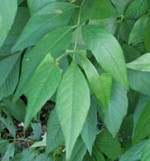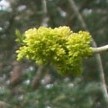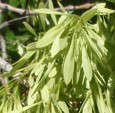 Also known as velvet ash, this deciduous tree is native to southwestern North America. It is a member of the olive family, Oleaceae, that also includes jasmine, privet, forsythia, and lilac. The branches are covered with gray bark that is tinged with red and deeply fissured in a diamond pattern. The leaves are pinnately compound, four to eight inches long, and composed of five or seven (sometimes three) leaflets. The leaflets are sometimes hairy, may be toothed or untoothed, and are 1 to 1.5 inches long and .75 to 1 inch wide. The foliage is light yellowish green turning yellow in the fall. Dense clusters of greenish female flowers and yellowish males ones are produced on separate trees in early spring before the leaves appear. Female flowers are followed in later spring or summer by light brown, winged seeds (samara), one inch long. Tolerates, desert soil, wind and seacoast conditions and is a often used as a shade tree and street tree.
Also known as velvet ash, this deciduous tree is native to southwestern North America. It is a member of the olive family, Oleaceae, that also includes jasmine, privet, forsythia, and lilac. The branches are covered with gray bark that is tinged with red and deeply fissured in a diamond pattern. The leaves are pinnately compound, four to eight inches long, and composed of five or seven (sometimes three) leaflets. The leaflets are sometimes hairy, may be toothed or untoothed, and are 1 to 1.5 inches long and .75 to 1 inch wide. The foliage is light yellowish green turning yellow in the fall. Dense clusters of greenish female flowers and yellowish males ones are produced on separate trees in early spring before the leaves appear. Female flowers are followed in later spring or summer by light brown, winged seeds (samara), one inch long. Tolerates, desert soil, wind and seacoast conditions and is a often used as a shade tree and street tree.

Type: Deciduous tree
Outstanding Feature: Foliage, fall color
Form: Narrow pyramidal when young; open, rounded headed with maturity
Growth Rate: Moderate to rapid
Bloom: . Dense clusters of greenish female flowers and yellowish males ones are produced before the on separate trees in early spring before the leaves appear.
Size: 30-40’ H x 15-30’ W
Light: Sun

Soil: Rich, moist, well-drained; tolerates drought and alkali
Hardiness: Zones 7-11
Care: Head up slowly when tree is young.
Pests and Diseases: Generally healthy but susceptible to red spider, scale, and aphids.
Propagation: Seed, summer cuttings, graphing, budding
Outstanding Selection:
‘Modesto’ (popular)
‘Rio Grande’ and ‘Fan Tex’ (nearly white bark, symmetrical rounded form)